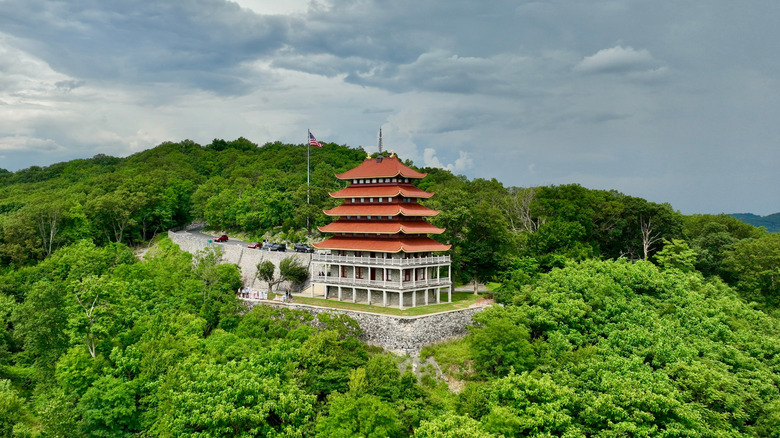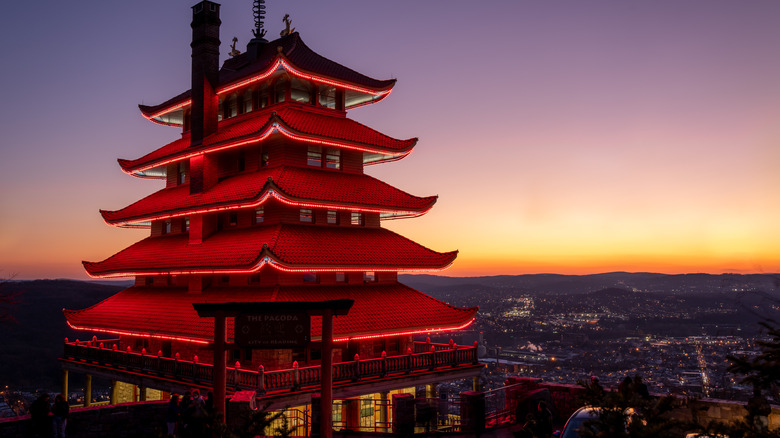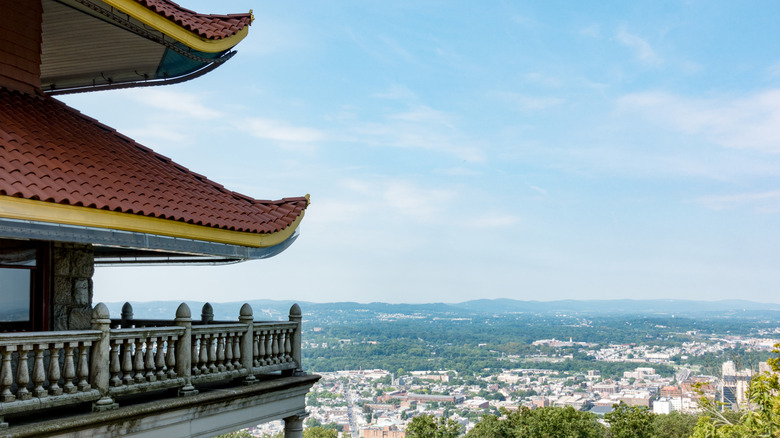Pennsylvania's Japanese-Inspired Pagoda Is A Historic Landmark Offering Sweeping Views Atop A Mountain
A glowing pagoda might not be what you'd expect to find in an otherwise classic Pennsylvania city, but if you're planning a trip to the Quaker State, that's what you'll see looming over the city of Reading. About an hour and a half northwest from Philadelphia — one of America's most underrated cities — Reading is known for its pretzels and for appearing as a railroad property on the classic Monopoly board game. The city's unlikely symbol, though, is the Reading Pagoda, a beloved landmark that's watched over the city for over 100 years.
The Pagoda sits on Mount Penn and within the Mount Penn Preserve, high up over Reading. Funnily enough, it's not the only Japanese-inspired marvel in the southeastern corner of Pennsylvania — another is the Shofuso Japanese House and Gardens, one of Philadelphia's best hidden attractions. However, built around 1906, the Pagoda far predates these gardens, and its history is a fascinating blend of cultural fusion and happenstance. Today, travelers can visit the Pagoda by driving up a single, bendy road along Mount Penn, climb its steps, and look out over the hills, rooftops, and railroad lines of Reading — which, from this height, really does resemble a Monopoly board square.
The unlikely story of Reading's Japanese-inspired Pagoda
Around 1906, William Abbott Witman, Sr. — a businessman who lost two mayoral elections in Reading — was shown a picture of the Nagoya Castle in Japan. It inspired Witman to construct his own Japanese-style temple. For his site, he chose the spot where he had once established a quarry, which had left an ugly smear on the horizon of Reading's landscape. The resulting Reading Pagoda was intended to become the centerpiece of a resort. The resort's plans fell through when the county denied Witman a liquor license — on the grounds that the meandering road up to the Pagoda was unsafe for drivers who might be intoxicated. The Pagoda was eventually sold to the City of Reading for the grand sum of one dollar. Since then, it's survived through anti-Japanese sentiments during World War II (which threatened it with demolition) and numerous repairs, earning itself a spot on the National Register of Historic Places.
The Pagoda has five red, tiered roofs, adorned with charming details like golden dolphin statues. A torii gate serves as the entryway to the Pagoda's grounds, and there's a viewing platform outside of the structure, with views that span up to 30 miles out on a clear day. One fascinating element of the Pagoda is found on its top floor: a bronze bell originally casted in the 18th century in Obata, Japan. It hung in a Japanese temple before Witman purchased it for his structure. On the sixth floor of the building, there's also a small museum with some artifacts and historical displays related to the Pagoda's curious origins.
Tips for visiting the Reading Pagoda
Once you pass through the torii gate, you'll find a parking area near the Pagoda. The entrance to the structure is through a gift shop (scope it out for a trinket bearing the building's likeness). Inside, the Pagoda has seven floors and almost 90 stairs to climb up them, which you can do after making a small donation. At the time of this writing, though, the interior of the Pagoda is closed for restoration. The grounds remain open from dawn to dusk, nonetheless, and it's worth the drive up for the Mount Penn views and to see the unique, historic structure up close.
Mount Penn's Skyline Drive — a 3-mile road that twists through the Mount Penn Preserve — will take you right up to the Pagoda's parking lot. At night, the drive becomes even more magical: Neon red lights, installed in the 1960s, illuminate the Pagoda. In spring, cherry blossom trees bloom around the grounds. To get there, the nearest major airport is Philadelphia International (PHL), about an hour and 30 minutes away by car. And if you've got time to spare after, take a 17-minute drive south to Adamstown, a Pennsylvania vintage paradise known as "Antiques Capital U.S.A."


